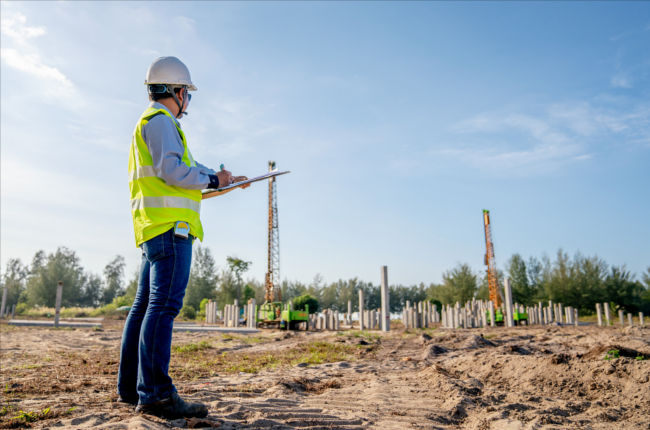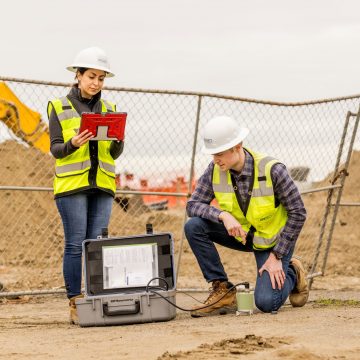A Comprehensive Guide to Coming To Be a Successful Geotech Engineer
Wiki Article
A Comprehensive Consider the Extent of Practice for Geotechnical Engineers and Their Influence On Task Feasibility and Threat Reduction
The range of method for geotechnical designers includes an array of critical obligations that directly affect task feasibility and risk management. What details techniques do geotechnical designers utilize to browse these intricacies properly?Roles and Obligations of Geotechnical Engineers
Geotechnical engineers play a critical function in the structure of building and construction tasks, making certain that frameworks are improved strong ground. Their obligations include a variety of activities necessary for assessing dirt and rock buildings, which straight affect task expediency and security. Initially, geotechnical designers conduct site investigations to collect critical information concerning subsurface problems. This includes boring boreholes, sampling dirt and rock, and performing in-situ tests to identify product characteristics.
Partnership is also a key element of their function; they work very closely with civil engineers, engineers, and environmental specialists to make certain that geotechnical considerations are integrated into general project planning. Inevitably, the competence of geotechnical designers is essential in promoting the safety, sustainability, and viability of construction ventures.
Secret Locations of Geotechnical Evaluation
Dirt samples and geological studies are fundamental components in the crucial areas of geotechnical analysis. These activities supply critical information relating to the physical and chemical buildings of the subsurface products, making it possible for engineers to analyze website problems precisely. The evaluation typically encompasses dirt category, compaction, shear stamina, and permeability, every one of which are necessary for understanding the actions of dirts under various loading conditions.Another considerable location of focus is slope stability evaluation, which examines the threat of landslides or dirt disintegration. This includes evaluating the geometry of slopes, soil kinds, and groundwater problems. Site characterization is additionally critical, as it includes a comprehensive investigation of the site's background, including previous construction, contamination, and all-natural risks.
Additionally, groundwater evaluation plays a vital role in geotechnical analysis, affecting both the design and building and construction stages. Understanding the groundwater table, flow direction, and potential changes is essential for effective foundation layout and stormwater administration.
With each other, these essential locations of geotechnical evaluation form a thorough framework that notifies decision-making procedures, making certain secure and lasting design practices while reducing potential risks connected with subsurface problems.
Influence On Job Expediency
The usefulness of a construction task hinges considerably on the understandings got from geotechnical investigations. These investigations provide important data relating to soil residential properties, groundwater conditions, and subsurface attributes, which are critical for figuring out the suitability of a site for building and construction. By examining factors such as soil bearing capability, negotiation capacity, and slope stability, geotechnical designers play a critical role in examining whether a project can continue as prepared or if alterations are required.Moreover, the results of geotechnical research studies directly influence job style and construction methods. Accurate geotechnical information enables notified decision-making, guaranteeing that architectural designs accommodate site-specific problems and adhere to regulatory requirements. This process aids in optimizing source allowance, therefore decreasing unforeseen delays and price overruns.
Additionally, a detailed geotechnical evaluation enhances the overall feasibility of a project by identifying potential difficulties early in the preparation phase. By attending to these challenges proactively, stakeholders can boost the job's probability of success, making sure that it meets both economic and practical goals. In recap, the payments of geotechnical engineers are like this important to developing project usefulness, therefore laying the groundwork for reliable project implementation.
Risk Reduction Techniques
While building and construction jobs naturally involve different unpredictabilities, applying effective risk mitigation methods can considerably reduce prospective issues occurring from geotechnical factors. Geotechnical designers play a critical duty in determining, assessing, and addressing dangers connected with subsurface conditions, guaranteeing that tasks proceed efficiently and stay within budget plan.One key method entails thorough website investigations, that include soil tasting, in-situ testing, and lab analysis. These evaluations provide vital information on dirt toughness, behavior, and structure, making it possible for designers to develop structures and earthworks that are both effective and safe. In addition, using advanced modeling methods, such as limited aspect evaluation, permits designers to predict how soil and structural communications may develop under various loading problems.
Another efficient reduction approach is the execution of suitable design adjustments, such as utilizing reinforcement strategies or adopting alternate construction approaches, which can enhance stability and decrease vulnerability to geotechnical concerns. Additionally, constant monitoring of website problems during building can facilitate prompt treatments, hence minimizing the possibility of unpredicted problems.
Instance Researches and Real-World Applications
Situation studies offer useful understandings right into the practical applications of geotechnical engineering principles and highlight the effectiveness of risk reduction approaches in real-world circumstances. One remarkable example is the building and construction of the Centuries Dome in London, where innovative ground therapy methods were executed to attend to challenging dirt conditions. By utilizing deep concrete blending and soil stablizing techniques, engineers successfully produced a secure foundation that mitigated potential negotiation dangers, making sure the task's feasibility.One more instance is the stabilization of the hillside for the new highway in The golden state, where considerable slope evaluation and surveillance were employed. Geotechnical designers utilized maintaining wall surfaces and drainage systems to take care of groundwater, significantly lowering the threat of landslides. This aggressive approach not only protected the integrity of the freeway yet also enhanced public security.
Moreover, the growth of a image source major airport terminal demonstrated the significance why not look here of complete site investigations. geotechnical industry. Geotechnical designers determined bothersome soil layers and suggested specific structure layouts, causing an effective task conclusion with decreased hold-ups. These situation researches emphasize the critical duty that geotechnical engineers play in assessing risks and implementing efficient solutions, thereby improving project expediency and total success
Verdict

By evaluating aspects such as dirt bearing capacity, negotiation possibility, and slope security, geotechnical designers play a pivotal function in evaluating whether a project can continue as planned or if alterations are necessary.
In summary, the payments of geotechnical designers are essential to developing task usefulness, thereby laying the groundwork for efficient task execution.
Geotechnical engineers determined bothersome dirt layers and suggested specific structure designs, leading to a successful project conclusion with reduced delays. geo tech engineering. These case researches emphasize the essential role that geotechnical engineers play in examining threats and executing reliable options, thus enhancing job expediency and overall success
Through effective danger mitigation techniques and the application of advanced modeling techniques, geotechnical engineers improve project end results and minimize risks connected to dirt and groundwater conditions.
Report this wiki page